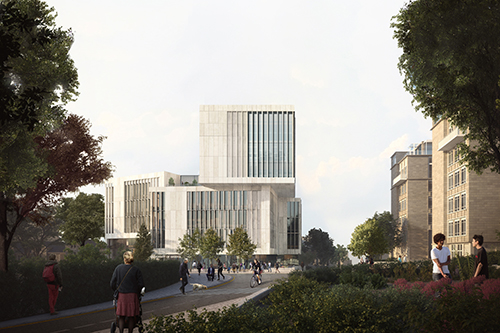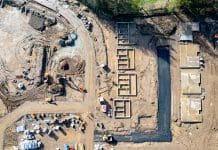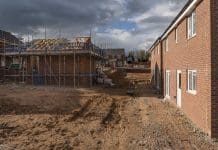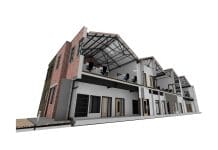
Plans for a landmark new library at the University of Bristol have been submitted to transform the heart of its Clifton campus and provide an architecturally significant new building
The University of Bristol has submitted a planning application for its landmark new library.
The new library will welcome students, staff and Bristol’s wider community by opening up the University of Bristol’s world-class cultural collections, which includes the University’s Special Collections and the renowned Theatre Collection.
The ground floor will be fully open to the public and is designed to be accessible to all. It will include a Changing Places facility for people who cannot use standard accessible toilets.
The new library will accommodate learning and research space, with capacity for around 2,000 new study seats, approximately 420,000 books and 70,000 journals and new study spaces. There will be exhibition galleries open to the public, an events space, a programme of activities, new public art and a café, all of which will be open to the whole community.
The landmark building, on the corner of Elton Road and Woodland Road, has been designed by a collaborative team formed by Schmidt Hammer Lassen, Hawkins\Brown and BuroHappold – companies behind some of Europe’s top education and library projects.
New library and wider remodelling plans
As part of the university’s wider plans to remodel its precinct around Tyndall Avenue, the new library will replace The Hawthorns – a former hotel which currently houses some student accommodation, catering facilities and various offices.
While modern in design, the library will be built in natural stone to be in keeping with the historic nature of listed buildings nearby. It features a stepped design to integrate with the local built environment.
It will meet high sustainability standards, with a focus on natural light, a high level of energy efficiency, a low environmental impact, and green roof terraces.
Plans also include a new civic square, with proposed new road layouts to improve traffic flow and public transport, enhance the pedestrian and cycling routes and make the whole area safer and accessible for everyone.
Dr Mike Entwisle, partner and global education Sector lead at BuroHappold Engineering, commented: “Central to our engineering response was the university’s requirement to achieve a truly sustainable building, promoting health and wellbeing, while meeting their ambition of moving towards a zero-carbon future.
“Floor to ceiling windows and an atrium at the heart of the space maximises natural daylight and views to the study spaces, promoting social connectivity. Suspended ceilings have been omitted in order to expose the elegant structure and utilise the thermal mass of the concrete frame to provide climate change resilience.
“Extensive building modelling has been undertaken to optimise passive and active environmental strategies and analyse a variety of future usage scenarios. The building will transform the student experience and enhance community engagement, and become an exemplar of sustainable and healthy building performance.”
Kasper Frandsen, partner at Schmidt Hammer Lassen Architects, said: “While we set out to create a contemporary design that echoes a sense of civic dignity imbued with timeless sculptural qualities, the new library is also deeply contextual and deliberately responsive to the historical environment of Bristol.
“Having worked closely with the University stakeholders, the library provides archive space for priceless physical collections while offering a social platform for study, exchange of ideas, and meetings between people.”
Adam Cossey, Partner at Hawkins\Brown, added: “This inspirational new landmark for Bristol will provide world-class facilities in an inclusive and welcoming environment.
“The new library building has the potential to transform the relationship between the University of Bristol and the wider city, extending a welcome to the public and acting as a gateway to the revitalised Clifton Campus.”
Consultation changes
Following a public consultation last October, a number of changes have been made to the building and road layout ahead of the planning application being submitted.
The scale of the building above ground has been reduced by the inclusion of a basement level and the entrance has been redesigned.
Other changes as a result of the public consultation include keeping Tyndall Avenue open to two-way traffic, arrangements to enable better traffic management measures for coach drop-off and pick-up, and making more of the university’s library collections accessible online.
Professor Judith Squires, deputy vice-chancellor and provost at the University of Bristol, said: “We are grateful to everyone for the feedback they gave as part of the consultation in October. Their comments have helped shape our latest plans for the creation of a world-class new University Library.
“It will not only provide an outstanding new space for our students and staff to research and learn but provides a unique opportunity for the University to create a new cultural space for all the citizens of Bristol to enjoy. The ground floor will be open to all and will be home to a new Cultural Collections Centre as well as a cafe, gallery and event spaces to host talks and exhibitions.
“We are also planning to enhance the public realm around the new University Library, turning a congested road junction into a calm and welcoming civic space, making the roads safer and creating new accessible public space for everyone to enjoy.”
Bristol City Council is expected to make a decision on the planning application in late Spring, when the university will be able to give more information on an anticipated timeline.













